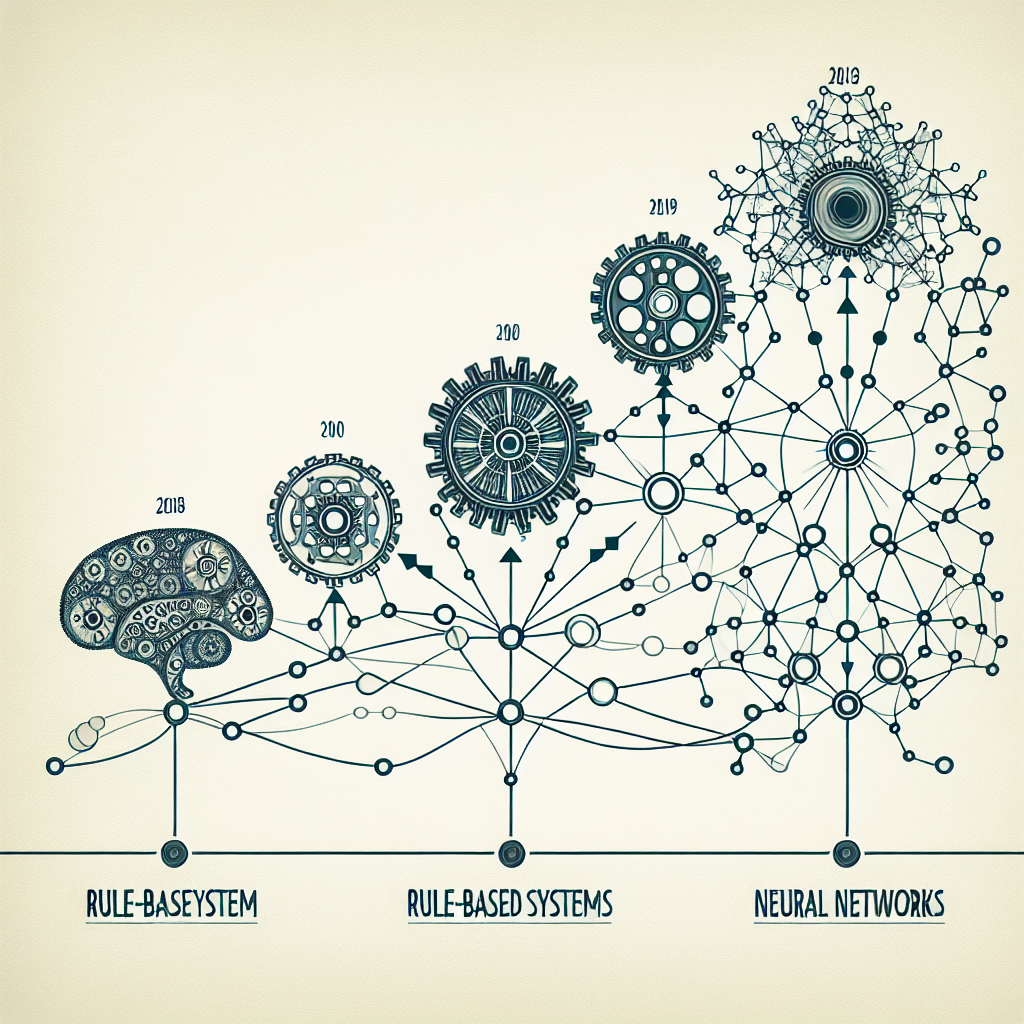Artificial Intelligence (AI) has come a long way since its inception, evolving from rule-based systems to sophisticated neural networks. This evolution has been driven by advancements in technology, increased computing power, and the development of new algorithms. In this article, we will explore the journey of AI development, from its early beginnings to its current state.
Early Beginnings: Rule-Based Systems
The concept of AI can be traced back to the 1950s, with the development of rule-based systems. These systems were built on a set of predefined rules and logic, which guided the decision-making process. While rule-based systems were able to perform simple tasks, they were limited in their ability to handle complex and unstructured data.
One of the most famous early AI systems was the expert system, which used a knowledge base to simulate the decision-making process of a human expert in a particular domain. Expert systems were widely used in fields such as medicine, finance, and engineering, but they were limited by their static nature and inability to adapt to new information.
The Rise of Machine Learning
In the 1980s, a new approach to AI development emerged: machine learning. Machine learning algorithms enabled computers to learn from data and improve their performance over time. This marked a significant shift from rule-based systems, as machine learning models were able to analyze large amounts of data and identify patterns that were not explicitly programmed.
One of the key breakthroughs in machine learning was the development of neural networks, which are algorithms inspired by the structure of the human brain. Neural networks consist of interconnected nodes, or neurons, that process and transmit information. By adjusting the weights of these connections, neural networks can learn to perform tasks such as image recognition, natural language processing, and speech recognition.
Deep Learning and Neural Networks
In recent years, deep learning has emerged as a powerful subset of machine learning, fueled by the development of deep neural networks. Deep learning models consist of multiple layers of neurons, allowing them to learn complex patterns and relationships in data. Deep neural networks have achieved remarkable success in various tasks, such as image classification, object detection, and language translation.
One of the key advantages of deep learning is its ability to automatically extract features from raw data, eliminating the need for manual feature engineering. This has enabled deep learning models to achieve state-of-the-art performance in a wide range of applications, from self-driving cars to medical diagnosis.
Challenges and Limitations
While AI has made significant progress over the years, there are still challenges and limitations that need to be addressed. One of the major challenges is the issue of bias in AI systems, which can lead to unfair or discriminatory outcomes. Bias can arise from the data used to train the model, as well as the design of the algorithm itself. Addressing bias in AI systems requires careful data collection, transparent decision-making processes, and ongoing monitoring and evaluation.
Another limitation of AI development is the lack of interpretability in deep learning models. Deep neural networks are often referred to as “black boxes,” as it can be difficult to understand how they arrive at a particular decision. Interpretable AI, or explainable AI, is an active area of research that aims to make AI systems more transparent and accountable.
The Future of AI Development
Looking ahead, the future of AI development holds great promise, with new technologies and approaches on the horizon. One area of focus is reinforcement learning, a branch of machine learning that involves training agents to make decisions in dynamic environments. Reinforcement learning has shown great potential in applications such as game playing, robotics, and autonomous driving.
Another emerging trend is the integration of AI with other technologies, such as the Internet of Things (IoT) and blockchain. By combining AI with IoT devices, for example, businesses can create intelligent systems that can analyze and act on real-time data. Similarly, AI and blockchain can be used to create secure and transparent systems for data sharing and verification.
FAQs:
Q: What is the difference between rule-based systems and neural networks?
A: Rule-based systems rely on predefined rules and logic to make decisions, while neural networks learn from data and improve their performance over time. Rule-based systems are limited in their ability to handle complex and unstructured data, while neural networks can analyze large amounts of data and identify patterns that were not explicitly programmed.
Q: What is deep learning?
A: Deep learning is a subset of machine learning that involves the use of deep neural networks. Deep learning models consist of multiple layers of neurons, allowing them to learn complex patterns and relationships in data. Deep learning has achieved remarkable success in tasks such as image classification, object detection, and natural language processing.
Q: What are some challenges in AI development?
A: Some of the challenges in AI development include bias in AI systems, lack of interpretability in deep learning models, and ethical considerations. Bias can lead to unfair or discriminatory outcomes, while lack of interpretability makes it difficult to understand how AI systems arrive at decisions. Addressing these challenges requires careful data collection, transparent decision-making processes, and ongoing monitoring and evaluation.
In conclusion, the evolution of AI development from rule-based systems to neural networks has been driven by advancements in technology, increased computing power, and the development of new algorithms. While AI has made significant progress over the years, there are still challenges and limitations that need to be addressed. Looking ahead, the future of AI development holds great promise, with new technologies and approaches on the horizon. By addressing these challenges and embracing new opportunities, we can unlock the full potential of AI and create intelligent systems that benefit society as a whole.

